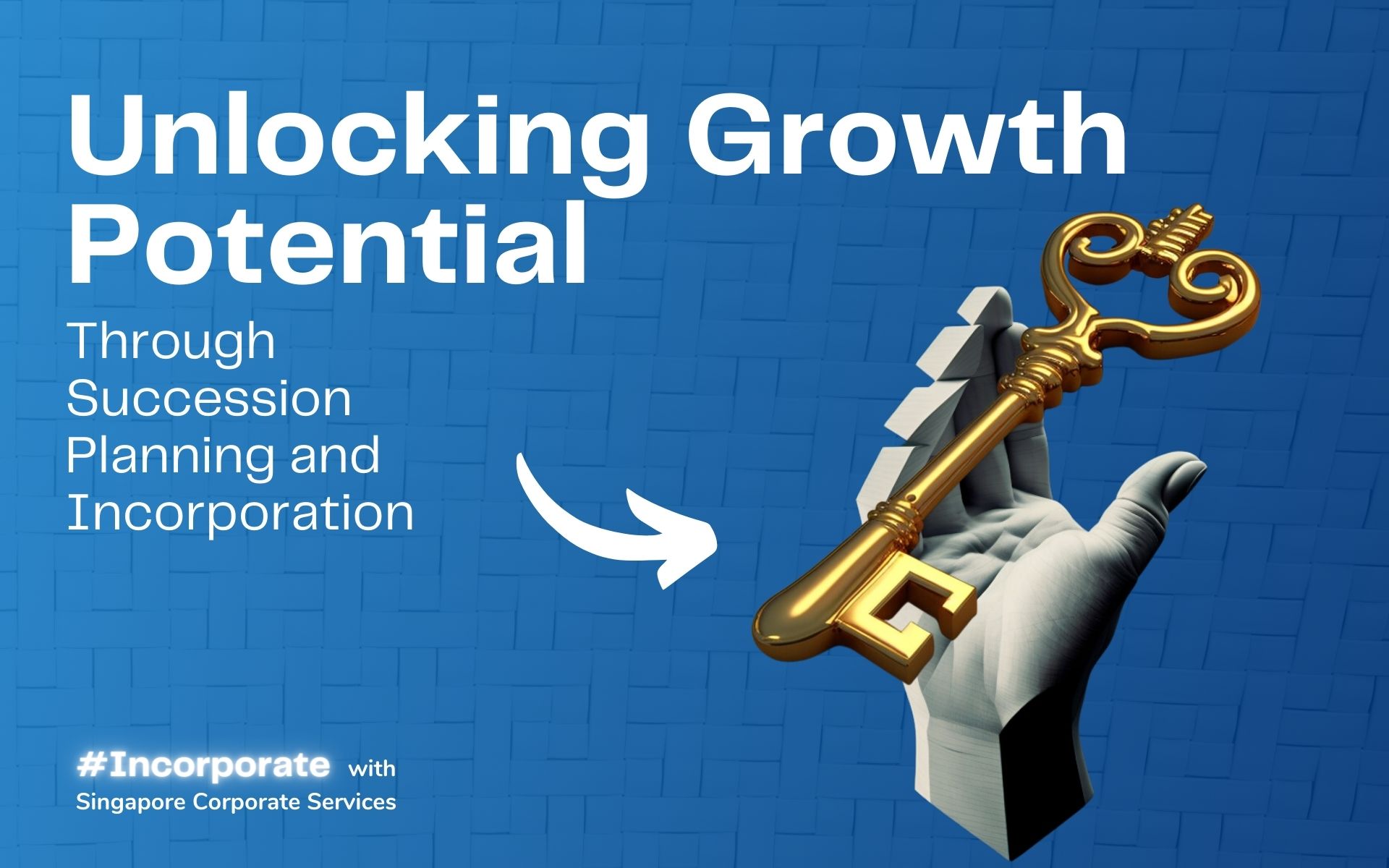Start with the end in mind
One way to think about the link between incorporation (or adopting the right governance structure) and succession planning is to “start with the end in mind.”
Whether you are an existing SME business owner that runs a private limited company, or an MNC with an international footprint, the business should plan beyond to outlive its leadership. Business owners need to think about who will ultimately run the organisation in the future, and what corporation structure would incentivise and facilitate that.
How Private Limited companies can approach succession planning
Private Limited companies can choose the most appropriate succession planning approach in their situation by considering a variety of factors, including their long-term goals, company culture, ownership structure, and available resources. Here are some examples of how companies can approach succession planning based on their unique situation:
- Keeping the business within the family: If the company is a family-owned and operated business, the owners may want to keep ownership and leadership roles within the family. To do this, they can identify potential family members who are interested and qualified for leadership positions within the organisation, and develop a plan to transfer ownership shares and leadership responsibilities over time.
- Transferring ownership to employees: If the company has a strong culture of employee engagement and ownership, the owners may want to consider transferring ownership shares to employees. This can be done gradually over time, and can be structured in a way that incentivizes employees to stay with the organisation long-term.
- Seeking external investment: If the company is looking to grow rapidly or expand into new markets, the owners may want to consider seeking external investment from venture capitalists or other investors. In this case, the succession plan may involve identifying a new CEO or other key leadership positions who have experience working with investors and growing companies.
- Developing a leadership pipeline: Regardless of the ownership structure or long-term goals of the company, developing a strong leadership pipeline is critical for ensuring long-term success. This can involve identifying potential leaders within the organisation and providing them with training and development opportunities to prepare them for future leadership roles.
Organisations need to think about what legal structure will best support their long-term goals and objectives. This could involve considering factors such as tax implications, liability protection, and governance structure. By starting with the end in mind and envisioning the ideal legal structure for their organisation, organisations can make informed decisions about whether incorporation is the right choice for them.
Companies in Singapore can use the Private Limited structure as a way to incentivise and protect the organisation for succession planning in several ways.
- Limited liability protection: The Private Limited structure provides limited liability protection for the company’s shareholders. This means that the personal assets of the shareholders are protected in the event of legal action against the company. This protection can help to incentivize shareholders to invest in the company and stay committed to its long-term success.
- Shareholder agreements: Private Limited companies can use shareholder agreements to establish clear rules and expectations for succession planning. For example, the agreement can outline how leadership roles will be filled in the event of retirement or other contingencies, and establish procedures for transferring ownership shares.
- Employee share ownership: Private Limited companies can incentivize employees to stay with the organisation long-term by offering them the opportunity to become shareholders through employee share ownership plans. By giving employees a stake in the company’s success, Private Limited companies can encourage them to stay committed to the organisation and actively participate in succession planning efforts.
- Structured governance: Private Limited companies are required to have a board of directors, which can provide structure and oversight for succession planning efforts. The board can work with the company’s leadership team to identify and develop potential successors for key leadership positions and establish clear procedures for filling those roles.
- Flexibility: The Private Limited structure offers flexibility for companies to choose the most appropriate succession planning approach in their specific situation. For example, they can choose whether to keep the business within the family, transfer ownership to employees, or seek external investment.
Keeping the Business Family-owned
Keeping ownership and leadership within a family-owned business requires a carefully planned and executed succession plan.
- Identify potential successors: The first step in keeping ownership and leadership within the family is to identify potential successors who have the skills and experience to lead the company into the future. This could involve evaluating family members who currently work in the business or identifying external candidates who could be brought into the organisation.
- Develop a clear succession plan: Once potential successors have been identified, the next step is to develop a clear succession plan that outlines the process for transferring ownership and leadership responsibilities over time. This plan should take into account the preferences and goals of all family members involved and include timelines for key milestones.
- Establish a governance structure: Family-owned businesses should also establish a governance structure that provides clear guidelines for decision-making and management of the company. This could involve creating a family council or board of directors made up of family members who are responsible for overseeing the succession planning process.
- Provide education and training: Family members who will be involved in the leadership of the company should receive education and training to prepare them for their future roles. This could include attending industry conferences, pursuing advanced degrees, or participating in leadership development programs.
- Communicate with stakeholders: Communication is critical throughout the succession planning process, both with family members and external stakeholders such as employees, customers, and suppliers. Regular updates and communication can help to ensure a smooth transition and build confidence in the future of the company.
Enabling Employee Shares
Enabling employee shares can be a great way for businesses to reward their employees and incentivize long-term loyalty. This involves developing an employee share scheme that meets the needs of the business and aligns. This could involve offering incentives such as discounts or additional benefits to encourage employees to participate or creating a vesting schedule where employees gradually acquire more stock over time. Incorporating with this in mind means:
- Establishing appropriate procedures: Businesses should also put in place an appropriate procedure for issuing and transferring shares in accordance with any restrictions that may apply, such as vesting schedules or limits on the number of shares each employee can hold.
- Developing rules for voting rights and dividend payments: Additionally, companies should create rules around voting rights and potential dividend payments associated with their employee share scheme if applicable. This could include establishing who holds decision-making power within the organisation or identifying how dividends will be paid out among shareholders.
- Complying with taxation regulations: Plus, businesses must ensure they are compliant with all relevant tax regulations when creating an employee share scheme, such as filing any necessary forms or paying any required taxes associated with issuing or transferring shares.
Enabling employee shares can be a great way for businesses to reward their employees and incentivize loyalty over time. By taking these steps, businesses can create tailored solutions that help them attract and retain valuable talent while allowing their staff to benefit from their efforts in return.
Developing a Leadership Pipeline with Shareholders
Shareholder rules and expectations for succession planning are designed to establish clear guidelines and expectations for how succession planning will be handled within a company. These rules and expectations can be established through a shareholder agreement, which is a legal document that outlines the rights, responsibilities, and obligations of shareholders in the company. Some common shareholder rules and expectations for succession planning include:
- Voting procedures: The shareholder agreement may also outline the voting procedures for selecting new leadership within the company. This could include specifying the number of votes needed to elect new leadership, or identifying the process for resolving ties or deadlocks in the voting process.
- Procedures for share transfer: The shareholder agreement may also establish procedures for transferring ownership shares in the event of succession or retirement. This could involve offering shares to other shareholders first, selling shares to an external buyer, or repurchasing shares from the shareholder who is retiring or leaving the company.
- Conflict resolution: The shareholder agreement may also outline conflict resolution procedures in the event of disagreements about succession planning. This could involve appointing a mediator or establishing a dispute resolution panel.
Ensuring that the company’s leadership selection process is transparent, and equitable by establishing clear guidelines and procedures, will enable shareholders to act in the best interest of the company and ensure a smooth transition of ownership and leadership over time.
How to Change Your Company Name in Singapore
A company's name can significantly shape its identity, yet there are times when a change becomes...
Is Singapore a Tax Haven? A Comprehensive Analysis
Is Singapore really a tax haven, or is it simply capitalising on tax policies that spur economic...
Fiscal Year vs Financial Year: Definitions and Implications
Is there a difference between a fiscal year and a financial year? While they both refer to the...




